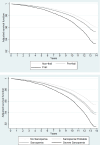Frailty or sarcopenia: which is a better indicator of mortality risk in older adults?
- PMID: 39393902
- PMCID: PMC11730048
- DOI: 10.1136/jech-2024-222678
Frailty or sarcopenia: which is a better indicator of mortality risk in older adults?
Abstract
Background: Despite the different conditions, frailty and sarcopenia overlap regarding their common link: the assessment of walking speed and muscle strength. This study aimed to compare the frailty phenotype to the sarcopenia using different cut-off points for low grip strength to determine which better identifies mortality risk over a 14-year follow-up period.
Methods: 4597 participants in the English Longitudinal Study of Ageing. Frailty was measured using the Fried phenotype. Sarcopenia (European Working Group on Sarcopenia in Older People 2) was defined using different cut-off points for low grip strength (<36, <32, <30, <27 and <26 kg for men and <23, <21, <20 and <16 kg for women), low skeletal muscle mass index (<9.36 kg/m² for men and<6.73 kg/m² for women) and slowness (gait speed: ≤0.8 m/s). Cox models were run and adjusted for sociodemographic, behavioural and clinical factors.
Results: When the coexistence of frailty and sarcopenia is considered, only the cut-off points <36 kg for men and <23 kg for women to define low grip strength identified the risk of mortality among individuals classified as having probable sarcopenia (HR=1.17, 95% CI 1.02 to 1.34), sarcopenia (HR=1.31, 95% CI 1.07 to 1.60) and severe sarcopenia (HR=1.62, 95% CI 1.33 to 1.96). In this situation, frailty identified the mortality risk (HR=1.49, 95% CI 1.22 to 1.81), whereas pre-frailty did not. Sarcopenia using other cut-off points for defining low grip strength did not identify mortality risk.
Conclusion: Sarcopenia using <36 kg for men and <23 kg for women as cut-off points seems to be better than the frailty phenotype for identifying the risk of mortality in older adults.
Keywords: AGING; EPIDEMIOLOGY; GERONTOLOGY; MORTALITY.
© Author(s) (or their employer(s)) 2025. Re-use permitted under CC BY. Published by BMJ Group.
Conflict of interest statement
Competing interests: None declared.
Figures

Similar articles
-
The feasibility of assessing frailty and sarcopenia in hospitalised older people: a comparison of commonly used tools.BMC Geriatr. 2019 Feb 15;19(1):42. doi: 10.1186/s12877-019-1053-y. BMC Geriatr. 2019. PMID: 30770722 Free PMC article. Clinical Trial.
-
Low gait speed is better than frailty and sarcopenia at identifying the risk of disability in older adults.Age Ageing. 2025 Mar 28;54(4):afaf104. doi: 10.1093/ageing/afaf104. Age Ageing. 2025. PMID: 40267307 Free PMC article.
-
European Working Group on Sarcopenia in Older People 2010 (EWGSOP1) and 2019 (EWGSOP2) criteria or slowness: which is the best predictor of mortality risk in older adults?Age Ageing. 2022 Jul 1;51(7):afac164. doi: 10.1093/ageing/afac164. Age Ageing. 2022. PMID: 35906934 Free PMC article.
-
Screening, Diagnosis and Management of Sarcopenia and Frailty in Hospitalized Older Adults: Recommendations from the Australian and New Zealand Society for Sarcopenia and Frailty Research (ANZSSFR) Expert Working Group.J Nutr Health Aging. 2022;26(6):637-651. doi: 10.1007/s12603-022-1801-0. J Nutr Health Aging. 2022. PMID: 35718874 Review.
-
Sarcopenia: European consensus on definition and diagnosis: Report of the European Working Group on Sarcopenia in Older People.Age Ageing. 2010 Jul;39(4):412-23. doi: 10.1093/ageing/afq034. Epub 2010 Apr 13. Age Ageing. 2010. PMID: 20392703 Free PMC article.
References
MeSH terms
Grants and funding
LinkOut - more resources
Full Text Sources
